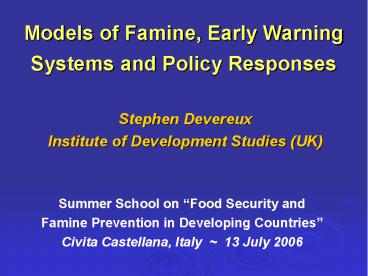Models of Famine, Early Warning Systems and Policy Responses - PowerPoint PPT Presentation
Title:
Models of Famine, Early Warning Systems and Policy Responses
Description:
Models of Famine, Early Warning Systems and Policy Responses Stephen Devereux Institute of Development Studies (UK) Summer School on Food Security and – PowerPoint PPT presentation
Number of Views:140
Avg rating:3.0/5.0
Title: Models of Famine, Early Warning Systems and Policy Responses
1
Models of Famine, Early Warning Systems and
Policy Responses
- Stephen Devereux
- Institute of Development Studies (UK)
Summer School on Food Security and Famine
Prevention in Developing Countries Civita
Castellana, Italy 13 July 2006
2
What is famine?
Why do famines happen?
- Climatic Theories
- Demographic Theories
- Sens Entitlement Approach
- Complex Emergencies
New directions in famine thinking
Famine early warning and response
3
WHAT IS FAMINE?
- A famine is a food shortage leading to
widespread death by starvation.
But famines have occurred
- with no food shortage Bangladesh 1974
- where death was caused by disease, not starvation
Sudan 1984
- with no excess mortality Sahel 1972-74.
4
A good outsider definition
- famine is a socio-economic process which causes
the accelerated destitution of the most
vulnerable, marginal and least powerful groups in
a community, to a point where they can no longer,
as a group, maintain a sustainable livelihood. - Peter Walker (1989)
5
WHY DO FAMINES HAPPEN?
6
Climate Theories
- Famine belts
- Drought causes famine
- Climate change.
Theories
- Crop production
- Assets (e.g. livestock)
- Food prices
- Community assistance.
Negative impacts
- Partial explanation
- Inability to cope is the problem
- Vulnerability needs to be addressed.
Critique
7
Demographic Theories
(1) Population increases indefinitely, but land
is strictly limited (2) The demand for food will
eventually exceed potential food
production (3) Famine acts as a natural check
on population growth.
Malthus
Critique
- (1) Malthus failed to foresee
- the agricultural revolution
- the transport revolution
- the industrial revolution
- the demographic transition.
- (2) Famine is not a Malthusian leveller.
8
Demographic Impact of China's 1958-62 Famine
1050
950
850
Population (millions)
750
650
550
Year
1954
1956
1958
1960
1962
1964
1966
1968
1970
1972
1974
1976
1978
1980
1982
9
Entitlement Approach
Four categories of entitlement
10
Entitlement failure
Subsis-tence
Labour
Trade Labour
Production Trade
Production
Pre-Drought Drought
11
Entitlement failure
Subsis-tence
Labour Transfers
Trade Labour
Production Trade
Production
Pre-Drought Drought
12
Strengths
- Demand-side emphasis
- Disaggregates food availability
- Analysis of boom famines.
Sens critique
- Fuzzy entitlements
- Legal rights only
- Choosing to starve?
More critiques
- Legalistic terminology
- Apolitical and ahistorical
- Dependency entitlements?
- Famine mortality.
13
Complex Emergencies
- War disrupts food production
- Food stores are destroyed or appropriated
- Trade and aid flows are disrupted
- Local economies are undermined
- Community coping strategies are undermined
- Government services are interrupted
- Refugees are created.
14
Famine as a sequence of entitlement failures
PRODUCTION ENTITLEMENTS Drought / El Niño / Conflict Population (Malthusianism)
MARKET-BASED ENTITLEMENTS Market failure/ collapse Exchange entitlement failure
TRANSFER ENTITLEMENTS Informal safety nets failure Food aid failure
15
NEW DIRECTIONS IN FAMINE THINKING
- Anti-famine social contracts India
- Accountability and the right to food
- Donor Government relations Malawi
- Pre-modern and Post-modern famine Iraq
- New Variant Famine HIV/AIDS.
16
Democracy and famine prevention
- INDIA AFRICA
Established democracy Emerging democracies
Limited civil conflict Conflict and insecurity
Free press Constrained press
Vigorous civil society Weak civil society
Low donor dependence High donor dependence
Anti-famine contract No anti-famine contract
No More Famines Persistent Famines
17
FAMINE EARLY WARNING
Famine Intensity Scale 1 Food
insecurity 2 Food crisis 3 Famine
4 Severe famine 5 Extreme famine Early
Warning Indicators Food Availability
Harvests food stocks Access to Food
Market prices Dietary Diversity Outcome
Indicators Malnutrition CMR Social
Indicators Coping Strategies Index.
18
Application of famine scales in Somalia
19
Building accountability from above First
level National Government
National government
Affected population
20
Building accountability from above Second
level Government Donors
Second level
Main pathway to accountability
World Food Programme
First level
National government
Affected population
21
Building accountability from above Alternate
route Food Security Ombudsperson
Alternative pathway to accountability
Second level
Main pathway to accountability
World Food Programme
First level
National government
Food security ombudsperson
Affected population
22
Building accountability from above Alternate
route Ombudsperson Right to Food
UN Secretariat Right to Food
Alternative pathway to accountability
Second level
Main pathway to accountability
World Food Programme
UN Office for Coordination of Humanitarian
Affairs (OCHA)
First level
National government
Food security ombudsperson
Affected population
23
CONCLUSION THE NEW FAMINES
- Past famines were understood as acts of God
(natural disasters, natural population growth) - Most contemporary famines are acts of man (they
are caused by human action or inaction) - Even when production and market failures occur,
famines are not inevitable until transfers also
fail - New famines are more political because they are
almost always predictable and preventable.































